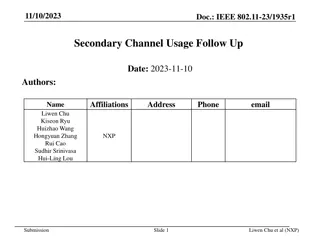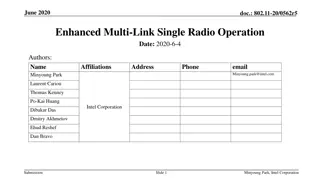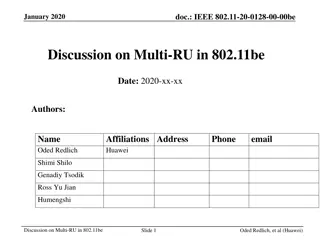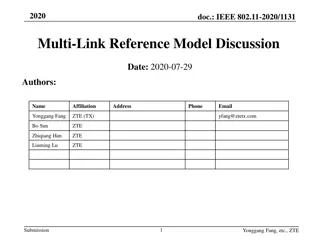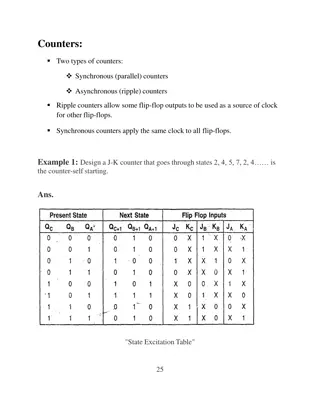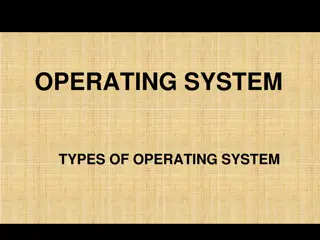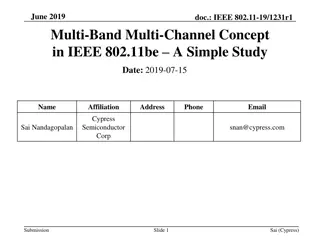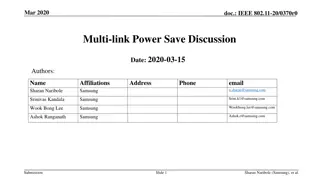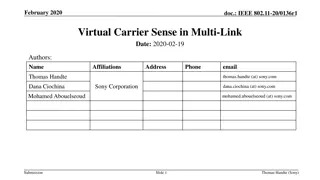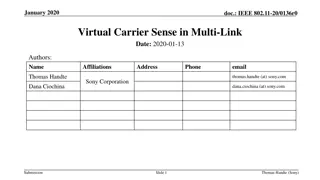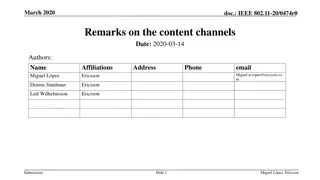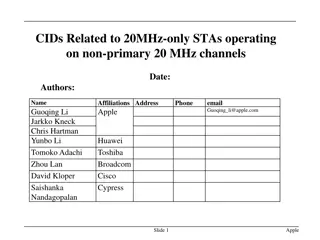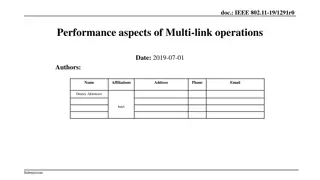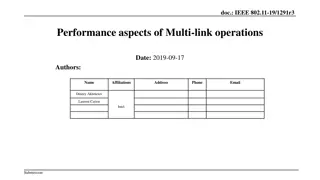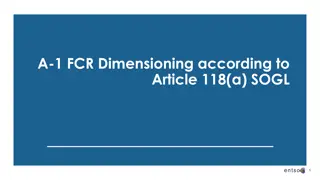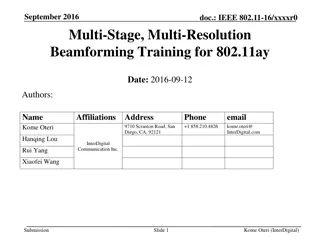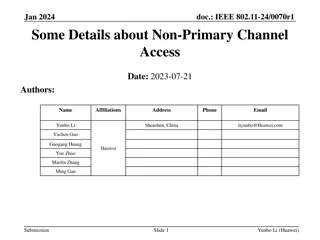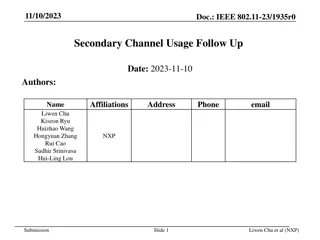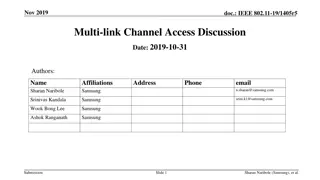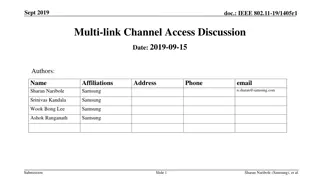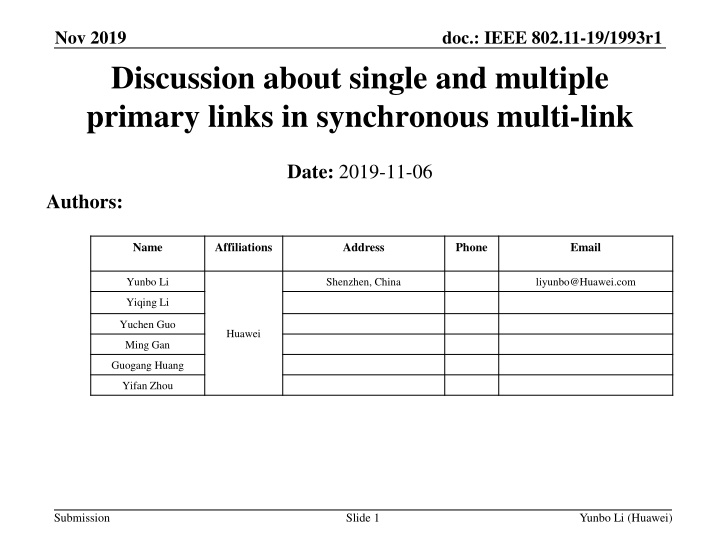
Discussion about Single and Multiple Primary Links in Synchronous Multi-Link
Explore the need for supporting non-Spatial Reuse (non-STR) Access Points in synchronous multi-link scenarios, analyzing scenarios involving different frequency bands and interference factors.
Download Presentation

Please find below an Image/Link to download the presentation.
The content on the website is provided AS IS for your information and personal use only. It may not be sold, licensed, or shared on other websites without obtaining consent from the author. If you encounter any issues during the download, it is possible that the publisher has removed the file from their server.
You are allowed to download the files provided on this website for personal or commercial use, subject to the condition that they are used lawfully. All files are the property of their respective owners.
The content on the website is provided AS IS for your information and personal use only. It may not be sold, licensed, or shared on other websites without obtaining consent from the author.
E N D
Presentation Transcript
doc.: IEEE 802.11-19/1993r1 Nov 2019 Discussion about single and multiple primary links in synchronous multi-link Date: 2019-11-06 Authors: Name Affiliations Address Phone Email Yunbo Li Shenzhen, China liyunbo@Huawei.com Yiqing Li Yuchen Guo Huawei Ming Gan Guogang Huang Yifan Zhou Submission Slide 1 Yunbo Li (Huawei)
doc.: IEEE 802.11-19/1993r1 Nov 2019 Introduction Base on STR capability, an AP Multi-link Device MLD can be either STR or non-STR STR means TX on one link and RX on another link concurrently Non-STR means TX on one link and RX on another link cannot be happened concurrently Base on the observations from Multi-link related presentations, there is no strong argument against STR for AP MLD STR or non-STR for non-AP MLD Divergences still exist for the following Support of non-STR for AP MLD; Single primary link or multiple primary links for non-STR MLD Primary link means the MLD will do backoff on that link. The terminology primary channel is also be used in many contributions. Because for the link that doesn t backoff may also has a primary 20MHz channel to support dynamic bandwidth, here we use terminology primary link to make it more clear. MLD or a non-AP Submission Slide 2 Yunbo Li (Huawei)
doc.: IEEE 802.11-19/1993r1 Nov 2019 Introduction Below two topics will be discussed in this document; Topic 1: Why non-STR AP MLD need be supported? i.e. the scenarios for non-STR AP MLD Topic 2: Single and multiple primary links for different types of AP MLD and non-AP MLD Submission Slide 3 Yunbo Li (Huawei)
doc.: IEEE 802.11-19/1993r1 Nov 2019 Scenarios for non-STR AP MLD(1/2) Scenario 1: 5GHz + 6GHz One important factor that affects the cross link interference leakage is the frequency gap between two links. Even with cross link interference cancellation (e.g. separate filters for 5GHz and 6GHz), the two links may be non-STR when the two links are close The frequency gap between 5GHz and 6GHz spectrum is very narrow, less than 100MHz. Mandatory STR will limit the flexibility of channel selection for each link; Depends on the spectrum in different countries, as well as the existing uses (include satellite communications, fixed wireless links, ) at 6GHz, it may be hard to find two far away links. Scenario 2: 6GHz + 6GHz There are much more legacy BSSs on 5GHz than on 6GHz, so it is very possible that the whole 6GHz is in very low traffic load, and has enough available bandwidth for two 6GHz links. Without two separate filters at 6GHz, it may not so realistic to support two STR 6GHz links, but it is possible to support two non-STR links. Slide 4 Submission Yunbo Li (Huawei)
doc.: IEEE 802.11-19/1993r1 Nov 2019 Scenarios for non-STR AP MLD(2/2) Scenario 3: non-STR hot spot When a non-STR non-AP MLD setups an hot spot, it becomes an non- STR AP MLD; It is a very popular use case for a non-AP STA to setup an hot spot; Mandatory STR at AP MLD side, will waste one of the two links which already equipped both hardware and software Scenario 4: So it is very important to keep non-STR mode for AP MLD when developing EHT specification. Submission Slide 5 Yunbo Li (Huawei)
doc.: IEEE 802.11-19/1993r1 Nov 2019 Multiple Primary Links for non-STR AP MLD For a non-STR AP MLD, multiple primary channels will have issues to support legacy STA and single link EHT STA; When a non-STR AP MLD transmit on link 1, the legacy STAs or single link STAs on link 2 can not know what happens on link 1, and may start UL transmission on link 1; Similar issue exists when a non-STR ML AP device transmit on link 2; So suggest to use single primary link for a non-STR AP MLD. AP MLD1 AP1 PPDU1 BA1 AP2 TA=AP1, RA=STA1 TA=STA1 Link 1 PPDU2 Non-AP MLD2 STA1 Link 2 TA=STA x, RA=AP2 STA2 Legacy STA STAx Collision period for AP MLD Submission Slide 6 Yunbo Li (Huawei)
doc.: IEEE 802.11-19/1993r1 Nov 2019 Multiple Primary Links for non-STR AP MLD When a non-STR AP use single primary link (e.g. link 1), both non-STR and STR non-AP MLD need to use single primary link, because When non-AP MLD use multiple primary link, when it use link 2 to communicate with AP MLD, the AP MLD will miss the packet in link 1 during its TX period on link 2. When a hidden STA (hidden from STA1) transmit to AP1, non-AP MLD2 can not know it, and may start UL transmission to AP MLD on link2. (see below figure) So when an AP MLD using single primary link, a non-AP MLD also uses single primary link. AP MLD1 AP1 AP2 PPDU1 BA1 TA=AP1 TA=STAx, RA=AP1 Link 1 Non-AP MLD2 STA1 PPDU2 STA2 Link 2 TA=STA 2, RA=AP2 Legacy STA STAx Collision period for AP MLD Submission Slide 7 Yunbo Li (Huawei)
doc.: IEEE 802.11-19/1993r1 Nov 2019 Effects of Multiple Primary Links For a STR AP MLD and a non-STR non-AP MLD, the use of multiple primary links needs new rules for both sides; For a non-STR non-AP MLD, once it transmits on link 1, it will lose the capability to monitor link 2, so it can not update the NAV, and also may lose the packet target to it on link 2; Some presentation mentions the AP MLD can help to piggy back the information of link 2 through response frame in link 1, but it only partially solves the problem; For example, when the transmitter of ongoing transmission in link 1 is an STA that hidden from the AP, the AP can not help at all. Additional, it still needs more research to check whether there are more other issues; For a STR AP MLD, it can not operate a pure independent EDCA, because it needs to check the capabilities and status of non-STR non-AP MLD on each link; It has issues for non-STR non-AP MLD to support multiple primary links, we need very carefully to evaluate if all the issues could be solved, as well as how much complexity will be introduced in order to solve these issues; It needs to add constrains for EDCA at AP MLD side when non-AP MLDs are non- STR. Submission Slide 8 Yunbo Li (Huawei)
doc.: IEEE 802.11-19/1993r1 Nov 2019 D2D issues for Multiple Primary Links For a non-STR non-AP MLD try to use multiple primary links, when it setups a D2D link (e.g. through TDLS), more issues will occur When the D2D peer is single link STA, the D2D peer can not communicate well with the non- STR non-AP MLD, because the D2D peer can not know what happens on another link; Same issue exists for a MLD D2D peer, when links are not fully aligned between the two D2D peers; Even the links of the two D2D peers align, when AP and D2D peer transmit on different link to this non-STR non-AP MLD on different links, the two transmission can not aligned, so collision will happens; (see below figure) If we consider the D2D peer are hidden from the AP MLD, the situation will be more complex. AP MLD1 AP1 BA12 TA=STA1 PPDU11 PPDU12 BA11 TA=STA1 AP2 TA=AP1, RA=STA1 TA=AP1, RA=STA1 Link 1 PPDU21 Non-AP MLD2 STA1 PPDU22 BA21 TA=STA2 Link 2 TA=STA x, RA=STA2 TA=STA x, RA=STA2 STA2 D2D STA STAx Collision period Submission Slide 9 Yunbo Li (Huawei)
doc.: IEEE 802.11-19/1993r1 Nov 2019 Single Primary Link The protocol design for single primary link is very simple, same to or similar as that of the 80+80MHz; Legacy STAs and single link STAs only associate on primary link, it will not bring issues that are discussed in previous slides; Does not introduce fairness issues between legacy STAs. Multiple primary links, and also allow one link to aggregate with another link will introduce fairness issues. Some simulations show the single primary link has low throughput gain compare with multiple primary links. But it is still has significant through gain compare with single link, especially at low load environment The gain is similar as when we compare with a BSS works on 80+80MHz and another BSS works on 80MHz Single primary link is a good candidate solution for non-STR MLD. Submission Slide 10 Yunbo Li (Huawei)
doc.: IEEE 802.11-19/1993r1 Nov 2019 Conclusion There are a lot of scenarios that an AP MLD need to work on non- STR mode, so it is very important to consider both STR and non- STR modes in the EHT specification; For a non-STR MLD, it needs to introduce complex procedure to support multiple primary links, but still have some remain issues need further investigate; For non-STR AP MLD, single primary link mode is needed; For non-STR non-AP MLD, single primary link is a good candidate. Submission Slide 11 Yunbo Li (Huawei)

